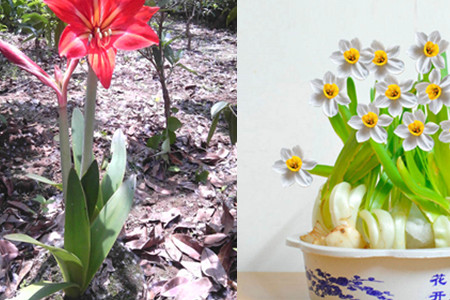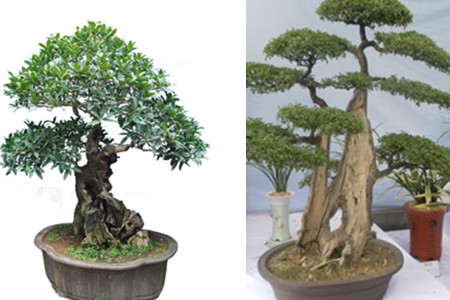How to plant bulbs and flowers can be propagated and sown in separate roots.

In our common flowers, many have a seed ball, as the name implies, the ball means that its root is as long as a ball, this is because its root abnormal expansion, from a fine root to a nearly circular bulb. This bulbous plant is divided into many varieties, among which we are more common, such as daffodils and lilies, but do you know how this plant propagates?
1. Split the root
For this kind of plant, the more common way of reproduction is to separate new plants from the roots. After this plant grows for a certain period of time, its root is no longer a seed ball, but grows a lot of small balls, at this time friends carefully break off these balls, you can grow more plants.
2. Cuttage
For this kind of plant, it can also be propagated only by cutting. Friends first cut the flowering branches into segments, be careful not to be too long, and then insert them into a soft matrix, or peel off the scales on the stem and bury them in the fine sand, and soon they will be able to grow new bulbs.
3. Sowing seeds
This method is suitable for almost all plants, and this kind of plant is no exception. Before formally sowing, pick out a full spare, then prepare a basin of nutritious soil, sow the picked seeds, and then sprinkle a very thin layer of soil. As for the supply of water, the soil can be soaked in a basin before sowing, or it can be sowed before sprinkling water.
All of these methods can breed new seed balls, but it is difficult to grasp the temperature. Friends can try it first.
Propagation method of Iris flavescens: ramet, sowing and bulb
Yellow iris is a kind of perennial herbaceous plant, the flower is yellow, it is very beautiful when it blooms, the flower contains 2 flowers, the flowering period is from May to June, we can see the figure of yellow iris in hillside grass and forest edge grassland, it has high horticultural value, the following is to learn about the breeding method of yellow iris.
Propagation method of Yellow Flower Iris 1. Ramet of Yellow Flower Iris
Ramet propagation is generally carried out every 2 to 4 years, in spring, autumn or after anthesis. Iris splits after anthesis (to avoid the rainy season). The flower buds can differentiate well before winter and blossom the following year. It is better to have 3 to 4 buds when dividing the rhizome. If the ramet is too small, it will affect the flowering of the following year. In ramet propagation, the upper leaves of the plant should be cut off and left about 20 cm for planting. Most varieties of Iris are suitable for shallow planting. The planting spacing varies according to the species, the strong species is 50 × 50 cm, and the general variety is about 20 × 20 cm.
A, applying sufficient basal fertilizer, the soil should keep high humidity during the growing period, especially at the flowering stage, the roots should grow in water, and the water depth 5~7cm is suitable.
B. Soil pH planting should be below 6.5. otherwise, the plant will grow slowly and yellowing may occur.
C. fertilize for 3 to 4 times during the growing period, and pay attention to the removal of weeds and withered yellow leaves. Summer high temperature, should often spray water to the leaf surface, increase air humidity, make seedling strong leaf green.
2. Sowing seeds of Iris flavescens
If the seed is used for propagation, it should be carried out immediately after the seed is mature, so that the seed is easy to germinate and can blossom in 2 to 3 years. Pot sowing from March to April, the optimum temperature for germination was 18-21 ℃, germinated 15-20 days after sowing, and transplanted when the seedling was high 5~6cm.
3. Iris flavescens bulb
After a year of planting and flowering, a seed ball will run out of nutrients and produce new roots, and there will be many bulbs around the new bulb, which can develop into a flowering ball after one or two years of planting. The world flower planting experts carry out tissue culture of axillary buds, bulbs, stem plates, flower stems and other different organs of Iris bulb to make it grow new bulbs, which provides a new way to accelerate propagation and cultivate disease-free strong mother balls.
Flowers suitable for sowing and propagation in May, and it is not too late to grow flowers in May.
May is coming, and many flower lovers think that they have missed the best time to sow flowers, so they give up your side of planting and cultivating flowers. In fact, this is not necessary. Now there are succulent flower beds for everyone to summarize the flower planting in May.
The climatic feature of May is that the temperature continues to rise, and the rainfall in our country increases gradually from south to north. After each fall of Rain Water, the temperature increases obviously. The weather with many spring rains turns to muggy after the spring rain of Lesser Fullness of Grain ends, which marks the beginning of summer soon.
Therefore, May at the turn of spring and summer is a key period for growing flowers, which plays an important role in laying the foundation for the growth of potted flowers in summer and autumn.
Species of flowers and trees suitable for courtyard display
In May, at the turn of spring and summer, temperatures rise sharply across the country, and the sun is getting stronger and stronger. More species of potted ornamental plants can be displayed in the courtyard Such as rose, Nanyang fir, Tripterygium, Canadian jujube, rubber tree, five-needle pine, Luohan pine, southern bamboo, Zhu Dinghong, jasmine, palm bamboo, cycad, king coconut, sunflower, mottled clover tree, palm, wine bottle coconut, cinnamon, beautiful needle sunflower, European spring, lily, dwarf pot, pomegranate, peony, Michelia, red maple, Milan, four seasons cinnamon, daidai and so on.
Breeding of courtyard flowers:
1. Sowing seeds
The species of grass flowers suitable for sowing in May are: spring of the four seasons, impatiens, thousand-day red, and so on.
Woody flowers are loquat, star anise gold plate, broad leaf ten meritorious work, loose tail sunflower, wine bottle coconut, sweet-scented osmanthus. Among them, the seeds of the first five kinds of flowers can be sowed as they are picked, but the fruits of sweet-scented osmanthus, which are blackened, softened and whitened, should be stored in clean wet sand until February next year, and then sowed when the seeds are white.
When picking and sowing seeds, we should pay attention to the following points when sowing: first, to keep the seedbed moist, but not stagnant water; second, to cover the grass to prevent the seeds from "budding"; and third, to remove the covered grass 2 to 3 times after seed emergence, and set up a shed in time to shade the young.
In addition, although loquat is a large seed, but its bud top soil ability is weak, easy to bend, sowing too deep will affect the emergence rate and seedling rate, so it is appropriate to shallow sowing, generally ditch depth of 2 to 3 cm to cover soil to ditch full.
At this time, gladiolus bulbs planted in the ground can blossom in August. The evening jade planted in the ground can blossom from August to September.
two。 Cuttage
Herbaceous ornamental plants suitable for cutting in May are: red, pansy, chrysanthemum, duckweed, longkou flower, four seasons begonia, bamboo crabapple, tortoise back bamboo, cold water flower, taro, candle, white netting grass, thousand-day red, marigold, colored leaf grass, pepper grass, geranium, coral flower and so on.
Succulent ornamental plants include epiphyllum, lotus, cactus as rootstock, trigonous arrow as rootstock, stone lotus, gemstone flower and so on.
Woody ornamental plants are: rhododendron, pearl orchid, jasmine, tiger plum, rose, hanging golden bell, Fusang, dragon spitting pearl, southern bamboos, red back cinnamon, ten meritorious works, rubber tree, dragon blood tree, red mulberry, eight immortal flowers, pomegranate, hibiscus, five-colored plum, plantain, triangular plum, goose palm wood, firethorn, purple magnolia, drunken fish grass and so on.
3. Grafting
In May, wild rose and other rootstocks can be used as rootstocks to bud rose.
Magnolia was grafted with one-to two-year-old Magnolia seedlings or cuttings as rootstock.
The two-to three-year-old rubber tree was used as the rootstock, and the tree was grafted with flowers and leaves.
The seedlings of Acer truncatum were used as rootstock and the tender shoots were grafted onto Acer truncatum.
The seedlings of Chimonanthus praecox with thick fingers were used as rootstock to graft the excellent variety of Chimonanthus praecox.
Osmanthus fragrans seedlings or lobular privet were used as rootstock to graft Osmanthus fragrans.
Camellia oleifera or Camellia mono-petal seedlings were used as rootstocks and shoots were grafted onto camellia.
The vigorous growth of rhododendron was used as anvil to split the western rhododendron.
Using Artemisia annua as rootstock, grafted chrysanthemum
In early May, cactus and trigonous arrow were used as rootstock to graft crab claw orchid.
Take the three-rowed arrow as the rootstock, graft the peony and so on.
4. Ramet
The flower species that can be propagated separately in May are: Hosta, purple calyx, Iris, one-leaf orchid, onion orchid, crabgrass, twelve volumes, Guangdong evergreen, orchid, jasmine, pearl orchid, chrysanthemum, chrysanthemum, begonia, kidney fern and so on.
5. Pressing strip
The flowers that can be propagated by striping in May are: Michelia, Pearl Orchid, Plum Blossom, Spring, Rose, Begonia, Cherry Blossom, Magnolia, Rubber Tree, Belgian Rhododendron, Osmanthus fragrans, Magnolia, Leaf Tree, Luohan Pine, Cui Bai, Zhenbai, Gardenia, Wisteria, Lingxiao, Milan and so on.
- Prev

What is the name of rose? beginners need to master these planting methods.
People who have raised rose flowers may know that rose flowers have strong vitality. They have a very strong vitality, strong adaptability, and the requirements for the soil are not very strict, so now many flower friends like this plant very much.
- Next

Does Chinese Flower Bonsai Iron Tree look good? sharing of breeding methods
The Chinese flower bonsai iron tree is usually placed in the office or at home as a bonsai, but the Chinese flower bonsai iron tree generally grows on a single head in the natural state, and is more famous for its flowering, which is called "iron tree blooming".
Related
- Fuxing push coffee new agricultural production and marketing class: lack of small-scale processing plants
- Jujube rice field leisure farm deep ploughing Yilan for five years to create a space for organic food and play
- Nongyu Farm-A trial of organic papaya for brave women with advanced technology
- Four points for attention in the prevention and control of diseases and insect pests of edible fungi
- How to add nutrient solution to Edible Fungi
- Is there any good way to control edible fungus mites?
- Open Inoculation Technology of Edible Fungi
- Is there any clever way to use fertilizer for edible fungus in winter?
- What agents are used to kill the pathogens of edible fungi in the mushroom shed?
- Rapid drying of Edible Fungi

